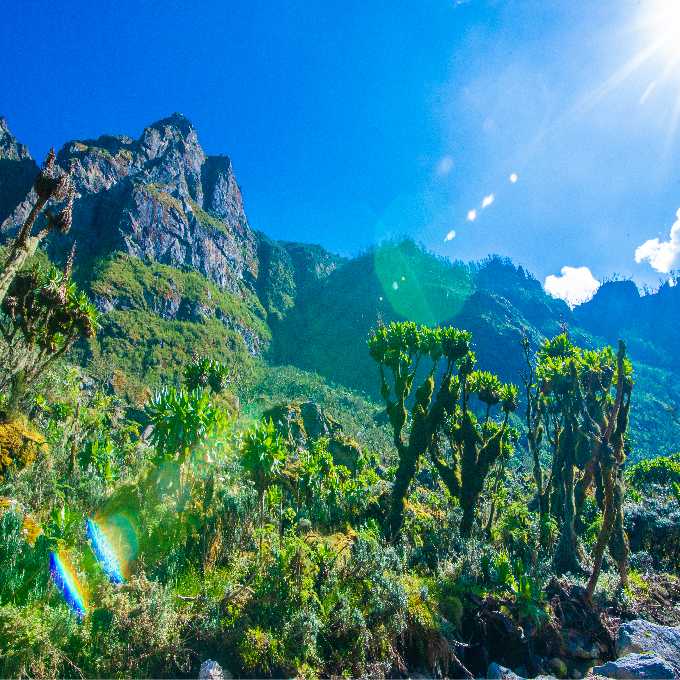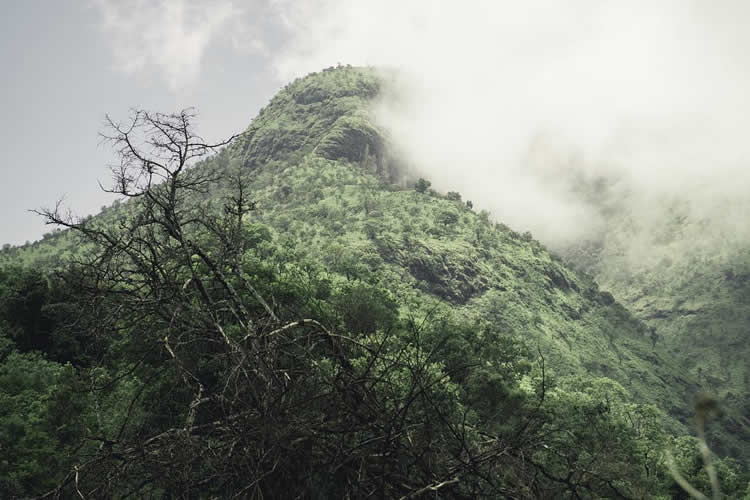Rwenzori Trekking – Hiking & Tours to Rwenzori Mountains
Explore the Rwenzori Mountains on a rwenzori trekking tour booked with 4×4 Africa the leading operator of Self Drive Safaris in Uganda, Kenya & Rwanda for unique visit to the Mount Stanley , Mount Edward and Mount Baker. Find the detailed information regarding the tips to plan Rwenzori Trek , Best time to visit and how to secure Rwenzori Permit .
In this guide, we will embark on a journey through the Rwenzori Mountains, offering insights, tips, and inspiration for those seeking to summit its majestic peaks and immerse themselves in its breathtaking beauty.

A Guide to Conquering the Rwenzori Mountains.
Rwenzori Mountains are tucked away in the heart of East Africa, the Rwenzori Mountains beckon adventurers with their snow-capped peaks, lush rain forests, and enchanting alpine landscapes. Fondly referred to as the “Mountains of the Moon,” this UNESCO World Heritage Site offers a trekking experience like no other, inviting intrepid explorers to conquer its rugged trails and unlock the secrets of its ancient glaciers.
The Rwenzori Mountains, located on the border of Uganda and the Democratic Republic of Congo, comprise a series of towering peaks, including Mount Stanley, the third-highest mountain in Africa. Renowned for their unique alpine environment and rich biodiversity, the Rwenzori Mountains offer a trekking experience that blends adventure with natural wonder.
Where is Rwenzori Mountains Located.
The Rwenzori Mountains, located on the border of Uganda and the Democratic Republic of Congo, comprise a series of towering peaks, including Mount Stanley, the third-highest mountain in Africa. Renowned for their unique alpine environment and rich biodiversity, the Rwenzori Mountains offer a trekking experience that blends adventure with natural wonder.

Geological Origins:
The Rwenzori Mountains are part of the Albertine Rift, a branch of the East African Rift system. They were formed over millions of years by volcanic activity, uplift, and glacial erosion. The range comprises several peaks, including Mount Stanley, Mount Speke, and Mount Baker, with Mount Stanley being the highest at 5,109 meters (16,762 feet).
he year but the best time is during the dry seasons between the months of June to August and December to March.
The Rwenzori Mountains are famous for their equatorial glaciers, which are among the few remaining in Africa. These glaciers have existed for thousands of years, with evidence suggesting that they were much larger during past ice ages. Today, the glaciers are shrinking rapidly due to climate change, posing significant challenges to the region’s ecosystems and water resources.
Rwenzori Hiking Trails
Choosing the right route for your trek in the Rwenzori Mountains is essential to ensure a safe, enjoyable, and rewarding experience. With various options available, ranging from day hikes to multi-day expeditions, it’s important to consider factors such as fitness level, trekking experience, time constraints, and personal interests. Here are some popular routes to consider when planning your adventure in the Rwenzori Mountains:
Central Circuit Trail:
The Rwenzori Central Circuit Trail is one of the most popular trekking routes in the Rwenzori Mountains, offering a comprehensive experience of the range’s diverse landscapes and ecosystems. This multi-day trek typically takes 6 to 8 days to complete and covers a circular route around the central peaks of the range.
Highlights of the Central Circuit Trail include traversing lush rainforests, crossing high-altitude moorlands, and summiting several peaks, including Mount Baker and Mount Stanley. The route also passes by beautiful alpine lakes, waterfalls, and panoramic viewpoints.
Kilembe Trail:
The Kilembe Trail, also known as the Western Circuit Trail, offers an alternative approach to exploring the Rwenzori Mountains from the western side. This route begins in the town of Kilembe and takes trekkers through the scenic valleys and ridges of the range.
The Kilembe Trail is less frequented than the Central Circuit but offers equally stunning scenery and diverse landscapes. Trekkers can enjoy panoramic views of the Rwenzori peaks, encounter unique flora and fauna, and visit attractions such as the Weismann Peak and Sine Hut.
Rwenzori Mountaineering

Rwenzori Packing Essentials:
When packing for your Rwenzori trek, prioritize essentials such as sturdy hiking boots, waterproof clothing, layers for changing weather, a good-quality backpack, and high-energy snacks. Don’t forget to pack a camera to capture the stunning landscapes and wildlife encounters along the way.
More about packing essentials.
When preparing for a trek in the Rwenzori Mountains, packing the right essentials is crucial for ensuring your comfort, safety, and enjoyment during your adventure. Here’s a detailed list of packing essentials to consider:
CLOTHING:
Moisture-wicking base layers: Lightweight and breathable shirts and pants to keep you dry and comfortable.
Insulating layers:
Fleece jackets or down vests for warmth during cooler temperatures at higher elevations.
Waterproof and windproof jacket: A durable outer layer to protect against rain, wind, and chilly conditions.
Waterproof pants or rain trousers:
To keep your lower body dry during rainy weather or when trekking through wet vegetation.
Hiking pants or convertible trousers:
Lightweight and quick-drying pants with zip-off legs for versatility in changing weather conditions.
Warm hat and gloves:
Insulating accessories to keep your head and hands warm during cold mornings and at higher altitudes.
Hiking socks:
Moisture-wicking socks with cushioning and support to prevent blisters and keep your feet comfortable.
FOOTWEAR:
Sturdy hiking boots:
Waterproof, ankle-supporting boots with good traction for navigating rugged terrain and variable trail conditions.
Camp shoes or sandals:
Lightweight footwear for wearing around camp or crossing streams.
GEAR AND EQUIPMENT:
Backpack:
A comfortable and properly fitted backpack with padded straps and hip belt to carry your gear and supplies during the trek.
Sleeping bag:
A warm and lightweight sleeping bag suitable for the expected nighttime temperatures in the Rwenzori Mountains. Sleeping pad or mattress: An insulated sleeping pad or mattress to provide cushioning and insulation from the ground while camping.
Trekking poles:
Adjustable trekking poles to provide stability, reduce strain on your joints, and assist with balance on uneven terrain.
Headlamp or flashlight:
Essential for navigating trails and campsites in low-light conditions or after dark.
Water purification system:
Water filter, purifier tablets, or UV sterilization device to treat water from natural sources and ensure safe drinking water during the trek.
Rwenzori Hike

Mount Stanley Peak

SUMMITING MARGHERITA PEAK:
For those seeking the ultimate challenge, summiting Margherita Peak, the highest point in the Rwenzori Mountains, is a bucket-list achievement. This multi-day trek requires stamina, determination, and proper acclimatization, but rewards climbers with unparalleled views and a sense of accomplishment.
More about Summiting Margherita peak.
Summiting Margherita Peak, the highest point in the Rwenzori Mountains, is a challenging yet rewarding adventure that offers breathtaking views and a sense of accomplishment like no other. Here’s what you can expect when embarking on the journey to Margherita Peak:
Preparation and Planning:
Summiting Margherita Peak requires thorough preparation and planning. Ensure you’re in excellent physical condition, with the stamina and endurance to handle long days of trekking at high altitudes. Acclimatization is crucial, so spend several days trekking at progressively higher elevations to adjust to the altitude.
Route Selection:
There are different routes to reach Margherita Peak, including the Central Circuit and the Kilembe Trail. Choose the route that best suits your fitness level, experience, and preferences. Be prepared for challenging terrain, steep ascents, and unpredictable weather conditions.
With three volcanic peaks – Sabyinyo, Gahinga and Muhavura, Mgahinga gorilla national park offers best hiking experiences. The names of these volcanoes have got meanings that are Sabyinyo means Old man’s teeth; Gahinga means Pile of stones and then Muhavura which means a guide. Of the three mountains, Muhavura is the highest and thus a traveler gets a higher advantage of sighting the peaks of other mountains when he or she climbs it. Walk through the different vegetation zone of the park including the mushy vegetation, bamboo forests and others while hiking to the top of these mountains or volcanoes.
Hiking

Visiting the twin lakes of Ruhondo and Burera

Before Mgahinga gorilla national park was gazetted as a national park, the Batwa people were the inhabitants and lived in the forests as hunters but later displaced though some of them remained around the park. The Batwa people are also encountered on the profits made after tourists visiting the national park. Also, these people entertain the travelers in many ways that is; through dances, songs, stories, poem, folks and others.
Where to stay?

There are several accommodation systems where one can stay at an affordable price and comfortably during a Uganda safari in Mgahinga. Among these accommodations include; Ikoro lodge, Mount Gahinga Rest Camp, Mount Gahinga Lodge, Lake Mulehe Safari lodge, Travelers’ rest hotel, Mutanda Lake Resort and many others.
When to go?

Mgahinga can be visited anytime throughout the year but the best time is the dry season that starts in June to August and in January and February.
How to access Volcanoes National park?

Volcanoes national park is easily accessed from Kigali and takes only two hour drive from Kigali to Musanze district in the Northern region of Rwanda. One can decide to use public means of transport from Kigali to Musanze and then use a private car to the headquarters of the park.
Also, one can hire services from the tour operator who will pick him or her up from the airport to the park headquarters in Kinigi.

